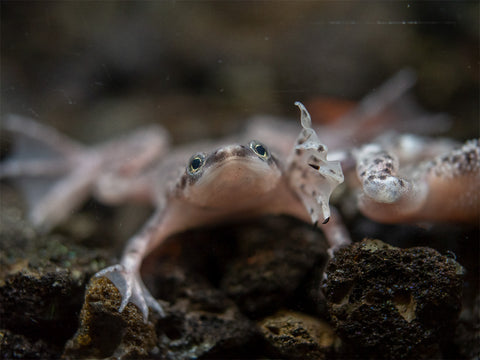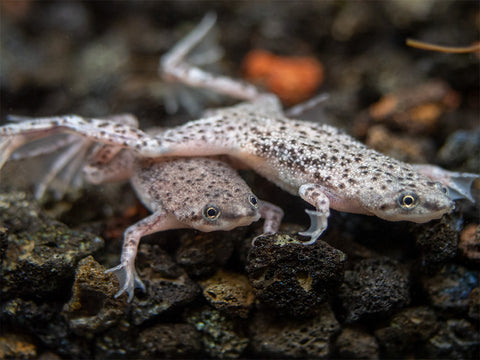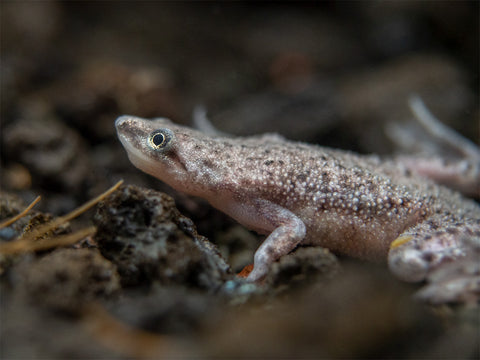Community Fish Spotlight: African Dwarf Frogs

Navigating the Waters: Ensuring Harmony and Care for African Dwarf Frogs
Introduction: Unveiling the Allure of African Dwarf Frogs
Within the realm of aquatic companions, lies a hidden gem often overlooked: the African Dwarf Frog (Hymenochirus curtipes). Though not technically fish, these fully aquatic amphibians possess a captivating charm that enchants aquarists worldwide. Join us as we delve into the captivating world of African Dwarf Frogs, exploring why they make an enchanting addition to any aquarium.
Meet the African Dwarf Frog: A Fascinating Amphibian
Habitat and Tank Requirements: Crafting an Aquatic Haven for African Dwarf Frogs
When contemplating adding African Dwarf Frogs to your aquarium, it becomes crucial to recreate their natural habitat. Opting for a spacious tank adorned with ample hiding spots and lush aquatic flora is essential, mirroring the verdant environments they inhabit in the wild. Ensuring pristine water quality, devoid of contaminants, is imperative to maintain optimal conditions for their health and vitality.
While some may be tempted to house African Dwarf Frogs in smaller tanks due to their size, it's important to note that smaller bodies of water can experience temperature fluctuations, which these frogs do not adapt well to. Therefore, providing a larger tank with stable water parameters is vital for the well-being of African Dwarf Frogs in captivity.

(Image Caption) Amphibious Nature: Despite being fully aquatic, African Dwarf Frogs still require access to the water's surface to breathe air. They possess lungs and need to surface periodically for oxygen.
Diet and Feeding Habits: Nurturing Your Aquatic Companions
Feeding African Dwarf Frogs is a simple affair, as they predominantly consume carnivorous fare. Offer a diverse diet comprising live or frozen delicacies such as bloodworms, brine shrimp, and daphnia. Supplement their meals with premium sinking pellets to furnish essential nutrients for robust growth and vitality.
Behavior and Social Dynamics: Reveling in the Quirks of African Dwarf Frogs
One of the most enchanting facets of African Dwarf Frogs lies in their charismatic behavior. These sociable beings thrive in the company of their kin, showcasing playful antics and forging strong bonds within a communal tank. Witnessing their graceful movements through the water or languid basking amid foliage is a source of sheer delight for aquarists.
Promoting Harmony: Choosing Compatible Tankmates for African Dwarf Frogs
When it comes to selecting tankmates for African Dwarf Frogs, the key lies in prioritizing peaceful species that share similar water parameters. This ensures a harmonious coexistence within the aquarium environment. It's crucial to avoid pairing African Dwarf Frogs with aggressive or significantly larger fish, as they may perceive the frogs as potential prey, leading to stress and conflict.
Ideal Tankmates for African Dwarf Frogs
Choosing suitable companions for African Dwarf Frogs involves selecting species with compatible temperament and environmental requirements. Optimal tankmates include:
-
Neon Tetras: These small, peaceful schooling fish add vibrant colors and activity to the aquarium while posing no threat to African Dwarf Frogs.
-
Corydoras Catfish: Known for their bottom-dwelling nature and social behavior, Corydoras catfish are compatible tankmates that help maintain a clean substrate.
-
Mystery Snails: Slow-moving and algae-eating, Mystery Snails contribute to the ecosystem's balance and are excellent companions for African Dwarf Frogs.
-
Rasboras: With their peaceful demeanor and petite size, Harlequin Rasboras make ideal companions, enhancing the visual appeal of the aquarium.
-
Otocinclus Catfish: These algae-eating catfish are non-aggressive and well-suited for aquariums housing African Dwarf Frogs, aiding in algae control.
-
Guppies: Known for their active nature and vibrant colors, guppies are compatible tankmates as long as they are not overly aggressive or prone to fin-nipping behaviors.
By carefully considering the temperament and needs of potential tankmates, you can create a thriving and harmonious aquatic community that fosters the well-being of African Dwarf Frogs and their companions.
Breeding and Reproduction: Unraveling the Mysteries of Frog Parenthood
Though challenging, breeding African Dwarf Frogs in captivity is feasible under suitable conditions. Furnish ample hiding places and simulate rainfall by adjusting water parameters to induce mating behavior. Following successful mating, anticipate the female depositing clusters of eggs, diligently guarded by the male until hatching occurs.

(Image Caption) Skin Shedding: Similar to other amphibians, African Dwarf Frogs periodically shed their skin as they grow. This process helps to keep their skin healthy and allows for proper growth.
Precautions Before Adding African Dwarf Frogs to Your Aquarium
Prior to introducing African Dwarf Frogs into your aquarium, careful consideration of various factors is imperative to ensure compatibility with existing tank inhabitants and overall well-being.
-
Potential Predatory Behavior: Exercise caution when housing African Dwarf Frogs alongside smaller tankmates such as baby shrimp and tiny fish fry to prevent predatory incidents.
-
Fin Nipping Tendencies: While typically peaceful, African Dwarf Frogs may exhibit fin-nipping behavior towards slow-moving fish species, necessitating vigilance during introduction to a community tank.
-
Competition for Food: Mitigate potential food-related conflicts by ensuring all aquarium inhabitants receive adequate nutrition, employing feeding strategies to accommodate the feeding habits of African Dwarf Frogs.
-
Tank Size and Environment: Assess aquarium size to ensure adequate space for exploration and concealment, maintaining optimal water parameters conducive to the well-being of all inhabitants.
-
Compatibility with Tankmates: Research the temperament and requirements of prospective tankmates to ascertain compatibility, avoiding aggressive or territorial species that may threaten the harmony of the aquatic ecosystem.
By adhering to these guidelines and adopting a proactive approach, you can establish a tranquil aquarium environment conducive to the well-being of African Dwarf Frogs and their tankmates, fostering a captivating aquatic tableau for enthusiasts to savor.
Q&A Section
Q: How many African Dwarf Frogs can I keep in less than 10 gallons of water?
A: It's recommended to keep no more than two African Dwarf Frogs in a tank smaller than 10 gallons to ensure they have enough space and to maintain good water quality.
Q: How many Dwarf African Frogs can I keep together?
A: African Dwarf Frogs are social creatures and can be kept in groups. However, it's essential to provide enough space and hiding spots to prevent overcrowding. A general guideline is to keep up to four African Dwarf Frogs together in a tank, depending on its size and filtration capacity.
Q: What aquarium plants can I keep with African Dwarf Frogs?
A: African Dwarf Frogs appreciate dense vegetation for hiding and exploring. Suitable aquarium plants include Java Fern, Anubias, Java Moss, Water Wisteria, and Amazon Sword. Ensure the plants are non-toxic and compatible with the tank's lighting and water parameters.
Q: What are common diseases that African Dwarf Frogs can get?
A: Common diseases affecting African Dwarf Frogs include fungal infections, bacterial infections, and parasites. Symptoms may include changes in skin coloration, lethargy, loss of appetite, or abnormal swimming behavior. Maintaining good water quality and providing a balanced diet can help prevent diseases.
Q: Can I hold my African Dwarf Frogs?
It's generally not recommended to handle African Dwarf Frogs frequently. Their delicate skin can easily be damaged, and they may become stressed when removed from the water. If handling is necessary for tank maintenance or health checks, ensure your hands are clean and wet to minimize stress and the risk of injury. Wash your hands immediately after.
Q: Are African Dwarf Frogs known to escape their aquarium?
A: African Dwarf Frogs are not typically known as escape artists, but they may attempt to explore if there are gaps or openings in the aquarium lid. It's essential to secure the tank with a tight-fitting lid to prevent any accidental escapes. Additionally, regularly check for any potential escape routes and seal them to ensure the frogs' safety.
And always remember to wash your hands thoroughly after handling any aquatic life in your aquarium to reduce the risk of contracting pathogens and bacteria.
To delve deeper into the specific care instructions for African Dwarf Frogs, we invite you to explore our product listing by clicking here.


